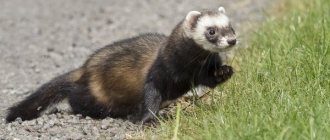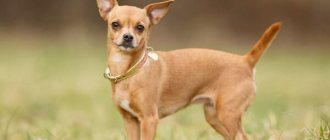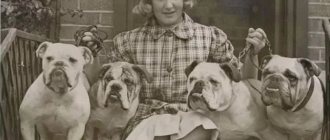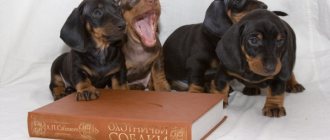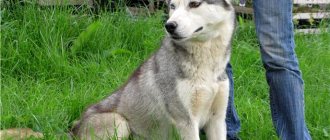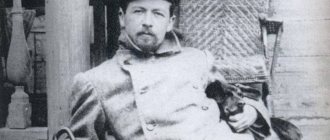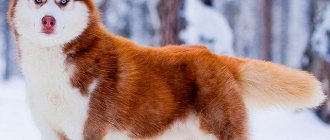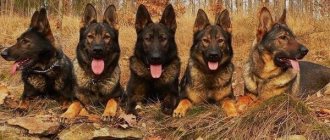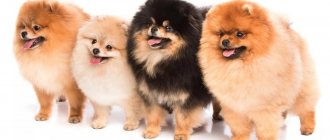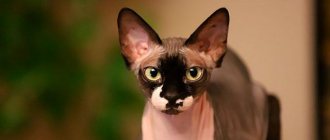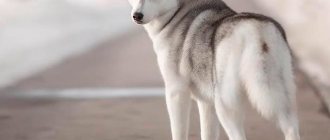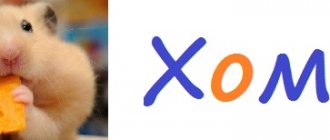Husky, having long ago ceased to be just a working sled dog, has turned into a popular exhibition and sporting breed; these dogs are also owned simply as a pet.
The fashion for them has led to the fact that the husky has become recognizable and even small children know that these animals look like wolves, that they have erect ears and blue eyes.
But this popularity has given rise to misconceptions, for example, many people think that there are other types of huskies or that these dogs only come in gray and black.
So are there any types of husky? What are they? And what should standard representatives of this breed look like?
Origin story
Husky is a collective name for a group of northern sledding breeds. Their purpose is to pull a team and transport small loads. These breeds are distinguished by their strength, endurance and ability to run fast.
The Chukchi are considered the “parents” of the husky. They crossed native species with wolves. The result was excellent working dogs capable of pulling sleds over vast distances. This made it possible to hunt large animals and expand the boundaries of their possessions. It was the Chukchi huskies that became the ancestors of the Siberian ones.
The Eskimos also appreciated wolf-like dogs and began to breed their own varieties. The name Husky comes from the abbreviation Eski: this is what Canadians called Eskimos. Northerners valued the breed not only for its fantastic endurance, but also for its unpretentiousness in food: they could be fed dry fish.
Sled dogs played an important role in the lives of their owners. They were full members of the tribe and were highly respected. According to some customs, huskies were invited into the house after the birth of a child and the dogs were allowed to warm the baby.
The Husky group includes:
- Siberian;
- Alaskan;
- Sakhalin;
- Japanese;
- Klee Kai (mini husky).
They have comparable performance data, but differ in appearance, character and habitat.
What did selection lead to?
Selection work can last for years and lead nowhere.
But there are also joyful moments when a new breed is bred and, subject to all formalities, elevated to official status.
There are several types of husky:
- Alaskan;
- Klee Kai or mini husky;
- Sakhalin;
- Siberian.
All these types of dogs are united both in appearance and behavioral attitude. However, there are also distinctive characteristics by which the variety is determined.
Certain dog breeds such as the Samoyed, Alaskan Malamute and Akita Inu are independent. They should not be confused with different types of huskies.
Because species and breed are different things. That is, just as there is a breed very similar to the husky, there is also a species of husky.
Now we will discuss all the generally recognized species step by step for better familiarization and subsequent selection of a dog.
Alaskan Husky
This variety is a mixed breed group that includes crosses of aboriginal breeds, malamutes, Siberian huskies and even pointers. It is formed on the basis of performance characteristics. Currently, the group of Alaskan huskies includes all non-northern sled breeds (or northern ones, but not registered in the FCI). Huskies came to the peninsula along with traders. Alaskans do not have a traditional breed standard. Individuals up to 66 cm tall and weighing up to 27 kg take part in the races.
General description:
- The head is cone-shaped, the muzzle is rectangular, tapered towards the end.
- The jaws are strong, with a strong grip, scissor bite.
- The eyes are almond-shaped, medium in size. The iris is colored blue, yellowish or brown.
- The ears are erect, triangular, set high, with pointed tips.
- The body is strong, with pronounced muscles. The outlines are rectangular.
- The tail is high-set, curled into a ring, and abundantly covered with hair. Usually thrown on the back.
- The limbs are strong, straight and muscular. Very powerful, with strong bones.
- Paws are oval shaped.
The coat is less dense than that of the Siberian Husky. Guard hairs of different lengths. This helps distribute the heat during a long run. The undercoat is thick and abundant. The color can be of any shade.
Alaskans are distinguished by their gentle nature and do not show zoo aggression. They love spending time with their relatives and often try to attract the attention of an unfamiliar dog. They are also highly trainable and not prone to dominant behavior.
Alaskans are naturally jumpy, easily overcoming a 2-meter fence. The owner will have to surround the house with a high fence.
Description of colors with photographs
According to the breed standard , Siberian Huskies are allowed any color except white , if it is associated with albinism, that is, with a complete absence of pigment in the dog’s body.
However, it should be taken into account that with any single-color colors there must be at least small white markings.
NOTE!
With most solid colors, the husky necessarily has lightening of the coat to white on the head, muzzle, neck, chest, belly, lower paws, and also, often, on the tail and the inside of the ears.
In addition, this breed is characterized by white markings such as a white mask, glasses and a shamrock-shaped forehead pattern.
Below are descriptions of colors with names and photographs.
Agouti
The color, also called “agouti,” is most characteristic of the racing husky variety. With this color, the guard hair has a gradient color: it alternates areas of black, gray and reddish shades, while the undercoat is usually cream-colored.
Piebald
Piebald is a very beautiful color. With this color, there are spots on the husky’s fur coat, the area of which should not exceed 30% of the total .
Marble
This is the rarest color of the husky, characterized by a marbled spotted coat pattern.
Pale yellow
Fawn is reminiscent of a light red color, but softer and more noble, somewhat similar to beige or dark cream.
Chocolate
This coat color is more like a dark copper color rather than a chocolate color. Characterized by special depth, brightness and saturation.
Brown
Can be any shade of brown, from light to dark chocolate.
Ginger
Red is a bright and rich shade, it can be quite light, golden-reddish, or almost red.
Black
This color requires the presence of at least small white markings on a jet-black background.
White
The shade of the purest snow-white shade is desirable; no colored spots or darkening on the coat is allowed in this color.
Sable
If the dog has a sable color, then the hairs have a lighter, fawn or red tint at the base and almost along their entire length, but their tips are darkened to black or, less often, dark brown.
Isabella
If a husky has an Isabella color, then such a dog looks very light, almost white, but the tips of its hairs are light fawn or reddish.
Siberian Husky
Siberian Huskies are indigenous dog breeds bred by the peoples of the Far North. This breed is genetically close to the wolf. During the Gold Rush it was imported to North America, where it became widespread due to its performance characteristics. Oddly enough, in their homeland, huskies were considered insufficiently promising and were excluded from breed registries. Dog breeding began in the USA, where the official standard was established.
Breed standard:
- Dimensions: height up to 60 cm, weight up to 27 kg.
- The head is medium in size, regular in shape, tapering from the back of the head to the eyes. The muzzle tapers slightly towards the nose. The nose is large, with well-cut nostrils. Its color depends on the type of color.
- The eyes are almond-shaped, medium in size. The iris is colored blue or brown.
- The jaws are powerful, well developed, with a scissor bite.
- The chest is of moderate breadth, set deep.
- The tail is sickle-shaped, similar to a fox. Should not be thrown on the back or hanging from the side.
- Limbs are straight and powerful.
- The body is strong, with well-developed muscles, and harmonious proportions.
The coat is straight and of medium length. The structure is not rough, soft. The coat is abundant and dense, effectively protecting against the cold. The undercoat is thick and well developed. May be absent during seasonal molts.
The color palette is very diverse. Siberians can be:
- white;
- gray-white;
- silvery white;
- red;
- chocolate;
- fawn;
- wolf color;
- sable;
- agouti;
- piebald;
- marble;
- splash coat;
- black-and-white;
- isabella;
- black.
There are about 20 types of colors in total.
Siberian Huskies have a friendly, affable disposition. They are not prone to aggression and cannot be guard dogs. This breed enjoys good health, but is prone to eye diseases, dermatitis and laryngeal paralysis.
Health and illness
Dogs have good endurance and excellent health, but are prone to certain diseases:
- cataract;
- atopic dermatitis;
- diabetes;
- hip dysplasia;
- entropion of the eyelid;
- corneal dystrophy;
- paralysis;
- endocrine diseases;
- glaucoma;
- perianal adenoma;
- testicular tumor.
A native of the northern regions is simply obliged to have excellent health, but this does not mean that the owner should not take care and monitor his condition.
When purchasing a Siberian Husky puppy, it is recommended to carefully read the information about the pet, study the pedigree and ask whether there are any serious genetically transmitted diseases in the family.
Sadly, Siberian Huskies can suffer from epilepsy. The disease cannot be cured, but it is quite possible to reduce the number of attacks if you take proper care of your pet.
It is recommended to carry out vaccinations on time and monitor the intake of vitamin complexes. Only careful monitoring of the dog’s condition can prevent the development of many diseases.
A dog should not be allowed to change its weight dramatically; both weight loss and obesity are harmful to it.
It is recommended to conduct a timely examination of the eyes, ears and teeth of the Siberian Husky dog, and also monitor the condition of the coat. His gait says a lot about his pet's health. If the dog begins to limp, it can be assumed that problems with the musculoskeletal system are beginning as a result of muscle damage.
The dog is a native of the Northern regions, so walks with the dog should be done in cool and shady places.
It is recommended to carry out deworming periodically. If your dog is feeling unwell, it is important to consult a doctor promptly.
Lifespan
Under good conditions and proper care, life expectancy is over 15 years.
Husky mini (Klee Kai)
Klee Kai is an original breed, bred in the USA in the 70-80s by Linda Spurlen and Eileen Gregory. The Klee Kai was probably the result of crossing Alaskan and Siberian Huskies. The creators of the breed have not yet “declassified” the data. Klee Kais are modest in size: the toy variety grows up to 33 cm, the standard Klee Kai - up to 42. Their weight ranges from 4 to 10 kg.
Mini-huskies are distinguished by a characteristic mask on their face and a tail curled into a donut. Overall, this is a miniature, well-built dog with a fluffy, thick coat. Klee Kais can be colored black and white, gray and white, and fawn.
They are known for their easy-going, playful nature and cat habits. Mini Huskies are great companions and get along well with animals. Due to the youth of the breed, they do not have genetic diseases, but 1 in 100 individuals suffer from blood diseases.
Types by coat type
Smooth-haired
The coat is two-layered, medium in length, and can be more or less short in different parts of the body. It consists of a dense and dense, but at the same time soft undercoat and a tougher spine adjacent to the body. During shedding, the undercoat comes out completely, making the dog look sleeker than usual.
Longhair
Long-haired huskies look very elegant, as their elongated hair forms beautiful fringes in the form of a mane and pants. The tail of the longtails is very fluffy, similar to a plume. However, despite the fact that long hair looks very elegant, according to the requirements of the standard, it is considered a serious fault.
IMPORTANT!
The long-haired husky is a good pet, but you should not expect such a pet to become a show winner.
Sakhalin Husky
Sakhalin Huskies are one of the oldest aboriginal breeds of the Nivkhs (a people living in the Amur region and Sakhalin). The historical name of the breed is Gilyak. They were used as sled and draft dogs. The breed was distinguished by its endurance and extreme unpretentiousness. During the winter season they were fed dried fish once a day. Currently, the Sakhalin people are almost extinct.
In appearance, they resemble a mix of Husky, Akita Inu and Spitz. In addition, Sakhalin residents are the largest representatives of the group. Males grow up to 70 cm and weigh up to 40 kg. The physique is distinguished by strong bones and well-developed muscles. The head is large, the muzzle tapers towards the nose. The ears are set high, triangular and fluffy. The coat is thick and abundant. The undercoat is dense and well developed. Pile length may vary. Available in all sorts of colors. The most common breeds are black, red, gray and brindle huskies. In the past, each color had its own cultural and religious meaning.
Sakhalin residents have a strong, fearless character, but need constant communication with their owner. Abandoned dogs become nervous and destructive. This species is prone to dominant behavior (especially males) and therefore requires firm and decisive leadership. Sakhalin residents do not know fatigue and can pull a team around the clock. These dogs require constant exercise.
Howl - the sound signal of a husky
One of the versions of the origin of the name “husky” is from the English word “husky”, which translated means “hoarse, hoarse.” This characterizes either the barking or the growling of a dog. Husky dogs practically do not bark, but you can often hear the characteristic howl of a husky, which causes mixed feelings in its owner.
Why do huskies howl?
For many people, a dog's howling evokes unpleasant emotions, and this is not surprising, since at all times this eerie “dog song” was regarded as an unkind sign. Moreover, the howl of a husky is sometimes so similar to the howls of a wolf, from which one certainly cannot expect anything good.
Why do northern dogs love to howl and growl hoarsely, and not make a loud, ringing bark like all other four-legged friends of man? The answer is quite simple: all huskies are residents of the northernmost parts of the world, where the air temperature sometimes drops below forty degrees. Naturally, barking at such low temperatures is not the most pleasant activity for dogs. In addition, the direct purpose of the husky is to move people and loads in dog sleds. While running, sled dogs spend quite a lot of energy pulling the load, and barking can be an additional burden for the dog while riding in a sled. Therefore, in order to save energy, huskies, tired of running quickly across the cold expanses of the north, prefer not to bark.
Many dog breeders believe that this is the reason why husky dogs communicate in a pack and with humans not by barking, but by howling.
Beautiful Eskimo legend about the husky
In addition to the “official version”, there is a beautiful Eskimo legend that explains this unusual “wolf habit” of huskies. It tells that one day God decided to tell people that death does not exist, and life lasts forever. A cheerful and lively husky got everything mixed up and accidentally distorted the divine message. She addressed people, telling them that death exists, but life cannot be endless. Since then, it has become a custom that husky dogs do not bark when they want to communicate, but emit a melancholy, drawn-out howl.
Howl is an expression of the entire palette of emotions in a northern dog
If huskies howl, this does not mean that they are sad. It’s just that northern dogs express all their emotions this way, including positive ones. The Internet is filled with videos of the “soulful songs” of these cute Eskimo friends. However, if the dog is carried away by his “emotional outpourings” and is disturbing others, it is necessary to stop the “concert on requests”, but not with a sharp ban, but simply switch the pet’s attention to another object that interests him.
Japanese Husky (Akita Inu)
Japanese Husky is the popular name for Akita Inu. They are one of the 14 oldest indigenous breeds. The Akita Inu's homeland is the Japanese island of Honshu. Traditionally used as watchdogs and hunting dogs. During the Second World War, the Akita was actively used as a service dog, so the owners began to cross it with a German shepherd in order to avoid being sent to the front (at that time, German shepherds were under state protection).
The Akita Inu is a Spitz-shaped dog that looks like a large husky. The Japanese grow up to 70 cm and weigh up to 40 kg. They are distinguished by a harmonious physique and long, dry limbs. The ears are triangular and set high. Almond-shaped eyes are set wide apart. The coat is thick and of varying lengths. The undercoat is abundant and soft. Color can be white, brindle and white-red.
These dogs are known for their calm nature and ability to be trained. A sharp mind allows them to make independent decisions. Akita Inu are prone to self-will and stubbornness. At the same time, they are brave, friendly and loyal dogs.
Varieties: name, description and photo
Thanks to many years of breeding work, there are many varieties of the Husky breed in the world . Each has its own distinctive features. Next, we will describe in detail what types there are, in addition to the well-known Siberian ones, and what are their differences, we will present a description of their character and photos of dogs.
Siberian
Siberian Huskies on a walk:
Mom and puppy are resting:
The most common breed, popular all over the world.
Sakhalin
Sakhalin Husky on a walk:
Resting after a walk:
A larger breed, up to 65 cm tall, weighing 30-40 kg. Loyal but freedom-loving dogs. Lifespan – 15 years. They perform well both as hunting dogs and as companions . The price of a Sakhalin Husky varies from 200 to 600 dollars.
These dogs are easy to train, but do not tolerate rough handling. When training, you need to be patient and kind.
Character
Huskies are sled dogs that have lived side by side with people for centuries. This made them capable of dialogue and real, sincere friendship. Northerners are friendly towards strangers and will not be able to act as a security guard.
Huskies have a special affection for children. They love outdoor games and are always ready to cuddle. These dogs make excellent nannies: they will never harm a child and will take care of his safety. Huskies are not prone to zoo aggression. They love to communicate with their relatives and get along well with cats, especially if they grow up together.
Sled breeds are distinguished by their intelligence and intelligence. The ancestors of modern breeds more than once had to make independent decisions during long transitions: survival depended on it. Their descendants have inherited a lively mind and often show stubbornness.
Husky is an active, cheerful breed. They love long walks with their owner and will happily support the game. Husky is suitable for sports owners who will take the animal for a run or bike ride.
In winter, huskies need to be harnessed to a sleigh. This is necessary for physical and psychological health. Northerners are made for work. While running in harness, they use all their abilities and resources, which helps maintain interest in life. Dogs locked in an apartment suffer from behavioral disorders and can die of boredom.
Description of the breed
medium-sized sled dog , distinguished by endurance, good speed qualities and the ability to navigate the terrain well.
Bred by tribes inhabiting the northern part of the Far Eastern region of Russia in ancient times, the breed developed and improved under harsh weather conditions and almost natural selection, since human intervention in the selection of pairs was insignificant.
Being left to their own devices in the warm season, sled dogs were forced to get their own food , thanks to which they developed a hunting instinct, which modern representatives of this breed have inherited.
Since in those tribes it was not customary to divide property and territory into theirs and someone else’s, people did not need sled dogs to have guarding or protective qualities.
NOTE!
The modern husky has a friendly and affable character, he is active and playful, although sometimes he is prone to mischief.
These dogs' inherent loyalty to their owners, love of children and ability to adapt make them suitable as family pets.
However, you need to take into account that training a husky may not be such a simple matter, since these dogs are very freedom-loving and independent, and if something does not suit them, they can become stubborn and stop obeying their owner.
Care and maintenance
Huskies are not suitable for apartment living. They need constant movement and a high level of physical activity. A bored husky can wreak havoc in an apartment or become lethargic and apathetic.
It is recommended to keep Northerners in a house with a spacious yard and a high (more than 2 m) fence well sunk into the ground. Huskies love to dig up the yard and will easily overcome a 2-meter fence. This breed easily tolerates frost, which means it is suitable for keeping in an enclosure. The main thing is that the enclosure is equipped with a booth and a warm floor.
Huskies cannot be kept on a chain! This is a sled dog, not a guard breed. Northerners are independent and freedom-loving, they love to participate in family life. If they are chained, they turn into unstable, deeply unhappy dogs.
Husky fur does not require careful grooming: they are known for their cleanliness and take care of their fur on their own. It is enough to comb your pet weekly and bathe it 1-2 times a year using special shampoos.
Northerners molt in autumn and spring. In spring, the dog sheds its winter coat, which manifests itself in complete loss of the undercoat. During this time, the pet is combed daily using a furminator. It is recommended to do this outside, otherwise the whole house will be covered in fur.
Huskies spend a lot of time outdoors, so their nails wear down on their own. If this does not happen, they are cut every 2 weeks. The ears are examined regularly and wiped once a month with a cotton swab dipped in warm water, or a special lotion is used.
You should not clean your ears with cotton swabs: they can easily cause injury.
The eyes are cleared of secretions as needed. They are wiped with cotton pads soaked in warm water or chamomile infusion. Movements should be directed towards the corner of the eye.
A husky's ears stand up at 2 months of age. If this does not happen, they are brought to a standing position using special structures. Also, we must not forget about regular vaccinations and oral hygiene.
How to care for a husky
The basic rules of care are to periodically check the animal’s ears, eyes and claws. With an active lifestyle, the latter wear off on their own, otherwise you will have to trim them.
Eyes and ears are examined and washed as needed. You can use special treats or a toothbrush and toothpaste to remove plaque from your teeth.
Grooming
Dogs' fur needs to be combed at least once a week, and during the shedding period this is done daily. Husky fur is special and should never be cut.
Important! Representatives of this breed do not like to wash themselves at all. Therefore, water procedures are carried out only as needed.
Proper diet for Siberian Husky
The diet may consist of homemade food or ready-made food. You cannot mix the two options. If the choice falls on ready-made food, then preference should be given to the premium and super premium categories.
Homemade food should contain the necessary elements and vitamins, in addition, be nutritious. You can include lean meat, poultry, cereals, vegetables, etc. in your diet.
Important! Dogs are prohibited from eating sweets, pickles, smoked meats and tubular bones.
Training and education
Huskies are pack dogs. They have a sense of collectivism. The strongest individual in the team becomes the leader. If one of its members is out of step with the general rhythm, the pack punishes the lagging behind. This means that the owner must have absolute authority. If you show weakness even once, the dog will sit on your neck. She will begin to impose her own routine on the family and dominate the owner.
Raising a puppy should be done from the first months of life. After the baby moves to a new home, the rules of behavior are explained to him, he is taught the toilet and diet. To toilet train a puppy you need to do the following:
- Cover the puppy's space with disposable diapers and gradually reduce their number. If the owner notices that the puppy is about to make a puddle in the wrong place, he should take the baby and transfer it to the diaper.
- To train a puppy to use the toilet outside, you need to take him out into the yard after eating, waking up and playing actively. It is important not to return home until the dog is done with everything.
- If the puppy does not get used to the toilet outside for a long time, you can take the soiled diaper out into the yard a couple of times so that he establishes a connection.
Dog training should be regular. Under no circumstances should you physically punish huskies: they do not respond to this method of suggestion. As punishment, it is enough to press its head to the floor or ground (this is what the leaders of the pack do) so that the dog comes to terms with the superiority of the owner.
Huskies require professional training. Mistakes in parenting can have unpleasant consequences in the future.
Photo gallery
So that you can make a choice in favor of one species or another, we offer you a photo selection of these amazing animals.
Mixture and comparison
Sled breeds were formed under comparable conditions, which is why there are dogs similar to huskies in color and appearance.
Huskies and huskies
They differ in their scope of use. Huskies are draft breeds bred in the North. Laikas are designed for hunting. Huskies are ready to work around the clock, huskies run out of steam much faster. Huskies are silent, reserved dogs. They express emotions by purring and howling. Laikas are big fans of making noise. Huskies have a powerful constitution, blue eyes and a bushy, fox-like tail. Laikas have an elegant structure, and their tail is curled into a donut shape.
Husky and malamute
Malamutes are designed to carry heavy loads at low speeds. Huskies are used to carry light loads over long distances. They develop high speed. The Malamute is larger and more massive than the Husky. Its average height is 60 cm. It is distinguished by its fluffy coat. The husky's pile fits well to the body.
For a malamute, blue eyes are a breed deviation, for a husky it is the preferred color. The husky has a crescent-shaped tail, while the malamute has a more furry tail. He moves like a fan. Huskies are not characterized by aggressiveness; it is easy to find a common language with them. Malamutes are strong, independent dogs that strive to dominate their owner. They quickly get bored with standard training. The owner must be able to keep the Malamute occupied, otherwise he will come up with entertainment himself.
Northerners are not only tireless workers, but also handsome. This inspires breeders to create unexpected crossbreeds. These include:
- A cross between a husky and a spitz. This mixed breed is called a Pomsky. He is a miniature Spitz-shaped dog with a characteristic husky color. Adults weigh from 3 to 14 kg, the size of the Pomsky is unpredictable. They have a friendly, playful nature and get along well with children.
- A cross between a shepherd and a husky. This beautiful mixed breed looks like a shepherd with blue eyes. Activity and friendly character are the heritage of the husky. Their appearance depends on the predominance of one or another blood. This crossbreed loves to imitate loud noises, including alarms and sirens. Also, these mestizos tend to run away from their owners, so they should not be lost sight of.
- A cross between a Husky and a Labrador. This hybrid looks like a Labrador with blue eyes. Cases of heterochromia are common. The character is dominated by the traits of a Labrador, but in a stressful situation the firmness inherent in a husky appears.
- Another common mixed breed is Akita Inu and Husky. He is a husky with the characteristic Akita coloring.
Mixed breeds are no worse than purebred dogs, but often suffer from genetic disorders. Therefore, when getting such a pet, you need to be prepared for unpleasant consequences.
Do colors change with age?
The color of an adult husky is difficult to predict. The fact is that during the first moults (at 6-10 months) juniors “rebloom” and change color. Whether the original color will remain the same, deepen or become more faded is impossible to predict.
For example, a copper puppy may turn red, while a bright red puppy may turn fawn. The “glasses” that give the look charm may also disappear.
Typically, the color of a husky changes slightly with age: the color fades and becomes less saturated.
How to choose a puppy
The best place to buy a puppy is a specialized nursery. The pedigree guarantees not only the purity of the blood, but also the absence of deviations. Puppies raised in kennels have social skills and are toilet trained. In addition, responsible breeders provide recommendations on feeding and maintenance. Inexperienced owners can always seek advice. To make an informed decision, you need to visit several exhibitions, read reviews on the Internet and look at babies from different litters.
At the screenings, pay attention to the following:
- organization of living space;
- nutrition;
- mother's health and appearance;
- condition of the puppy’s coat, skin, teeth, eyes and joints;
- absence/presence of discharge from the nose and eyes;
- communication between puppies;
- reaction to strangers;
- activity (puppies should not be lethargic or hyperactive: both conditions are abnormal);
- declared set of documents and pedigree.
It is recommended to take an experienced owner or specialist to the viewing: they will help take into account all the nuances.
Where to buy and price
Siberian and Alaskan huskies are common breeds in Russia, so buying a purebred baby will not be difficult. Akita Inu is considered more rare, but in cities with a population of over a million there will definitely be a nursery. Sakhalin Huskies are on the verge of extinction, so it is almost impossible to purchase such a puppy. Klee Kai is also a rare breed: less than a dozen kennels are registered in Russia and the price of a puppy can reach up to 350,000 rubles.
Siberian Husky kennels:
- Khaskvisher (Moscow and Vladimir region);
- Vento Libero (Moscow);
- Free Flock (Moscow).
Average cost: 25,000-50,000 rubles.
Aliski Husky Kennel:
- Silver of the North (Samara region).
The breed is not officially recognized, so the cost of puppies depends on the seller’s price tag.
Akita Inu kennels:
- Indigo Smile (St. Petersburg);
- Mai Hoshi (Moscow);
- Milana Light (Penza).
Average cost: 40,000-70,000 rubles.
Nicknames for a husky boy: Alex, Altai, Thunder, Max, Wolf, Odin, Dingo, Zorro, Zeus, Cosmos, Lazar, Fox. Names for husky girls: Aurora, Alma, Bella, Gerda, Runa, Fairy Tale, Umka, Freya, Tessa, Eva, Elsa.
Selection and price of a puppy
How much do husky puppies cost? In fact, the price can be from 25 thousand rubles. up to 50 thousand rubles* It all depends on the type of breed and the nursery from which the kitten is taken. The largest establishments where purebred dogs are sold are located in Moscow. The second place where you can pick up a husky puppy for a price above average is St. Petersburg.
Note! If you do not plan to take a dog for an exhibition, you can get by with a more budget option. But you need to be careful and get to know the puppies’ parents or study their documents. Otherwise, you can buy a very expensive mixed breed that will simply look like a purebred, or a dog with congenital defects.
So who should own a husky? It should be understood that this is not a lap dog; it needs space and movement. Therefore, it is recommended to keep them in private houses or apartments, but on condition that the owner can take care of such a temperamental dog.
*Prices are as of November 2022.
Pros and cons of the breed
| + | – |
| Ideal working and sled dog | The rarity of some breeds and their high cost |
| A wonderful companion | Not suitable for apartment living |
| With proper upbringing, he gets along with cats. | Heavy seasonal shedding |
| Good with children | Requires professional training |
| Does not require careful care | May be stubborn and self-willed |
| Easily trainable | Requires a high level of physical activity |
| Suitable for active owners |
Huskies are hardy, freedom-loving dogs. They cannot be locked in an apartment and walked twice a day. Northerners need constant activity and will wither away from boredom and idleness. Huskies need a decisive, strong owner who will become his absolute authority. Keeping this breed is a big responsibility. The northerners will spin out of control as soon as they feel the weakness.
How much do snow dogs cost?
Many people who have decided on the breed of their future pet may be interested in the question: how much does a husky dog cost, and where can it be purchased? The cost of dogs of this breed depends on many components; the average price of a husky is 18,000-22,000 rubles.
But the value of northern dogs does not depend on how much a husky costs: by purchasing a fluffy puppy, a person finds a devoted friend, a cheerful and cheerful companion with whom you can go on exciting hiking and cycling trips, and maybe even take part in sled dog competitions.
Reviews
You can find many reviews about Japanese huskies on the Internet; we will publish only a few of them. Anna Petrovna, Khabarovsk:
- “I was always against dogs in the apartment, until my daughter brought such a cute puppy that I couldn’t resist. Our Rose changed my understanding of dogs. This is a very touching, obedient, affectionate animal, which must be treated responsibly and given time. I can't even call her a pet. She became part of our family."
Andrey Petrovich, breeder from Vladivostok:
- “The Japanese Husky is not made for an apartment and many people forget about this or don’t even want to think about it. This is a large working dog, accustomed to serious workloads, and not a cat who can curl up on the windowsill and sleep all day. If you want to have an Akita Inu, then think not only about your desires, but also about the needs of the pet, and soberly assess your capabilities.”
Coat and colors
The coat consists of straight, smooth guard hair of medium hardness and soft, dense undercoat. The standard allows medium-length hair that emphasizes the contours of the body.
Long-haired Huskies are not welcome. Shaggy hair quickly falls off, hides the silhouette, and disrupts thermoregulation. Long hair is more difficult to care for.
Among huskies, it is impossible to find two identical dogs. Each puppy has its own color combinations and coat pattern. Colors can be combined into common suits:
- Gray with white or wolf color.
- Black combined with white or tan.
- Shades of brown and red - copper, chocolate.
- Fawn – muted cream tones.
Isabella color husky puppy.
American and European breeders counted more than 20 colors. Russian dog handlers recognize as “correct” only the color white in combination with brown, gray, and black tones.
Pure white huskies are rare.
The head of colored huskies is decorated with a light mask and vertical stripes on the forehead.
Character and temperament
Huskies have developed a peaceful attitude towards people over thousands of years. Sled dogs lived in harsh conditions. During snowstorms and severe frosts, owners would let dogs into their homes so that they could warm the children with their warmth. The slightest manifestations of aggression were immediately suppressed, and evil individuals were excluded from breeding.
Huskies are not capable of biting or offending either an adult or a child. They enjoy playing with babies. If you don’t like something, they simply move aside. Sometimes an animal becomes so attached to a younger family member that it accompanies him everywhere, without leaving his side even during sleep.
It is useless to teach Siberian Huskies to guard and defend. They are too friendly towards strangers, so in a dangerous situation they do not expect help from dogs. Attempts to train a pet to guard property or develop aggression towards strangers break the animal’s psyche. Such experiments end disastrously for the owner and family members.
Siberian Huskies have lived in canine communities for centuries, so they get along well with other dogs. They get along well with cats if they grow up nearby. Other people's cats are treated like prey.
Sled dogs were fed only in winter; in summer they were allowed to free themselves. In search of food, they caught small animals. Domestic rodents and birds also awaken hunting instincts, but dogs clearly distinguish between “friends” and “strangers”.
Bad habits
Siberian Huskies love to dig holes in the road, garden beds, make holes under fences, and lift linoleum in apartments. There is no use scolding animals. It is better to find and show an area where you can dig without damaging the farm.
The habit of digging holes has been noticed in huskies since childhood.
Huskies rarely bark, but they can produce a lot of intonations with their voices: they grumble, whine, and growl. Sometimes they howl from boredom or lack of physical activity. The only way to overcome this habit is to walk longer and more often.
On walks, huskies rush forward and pull on the leash. You will have to make a lot of effort to train your pet to walk next to you.
Huskies are smart, but freedom-loving and independent animals, so they are difficult to train. These properties are also innate. Sled dogs more than once saved drivers and cargo, avoiding invisible cracks and holes in the ice. Therefore, people gave dogs the right to make their own decisions in choosing a route.
Siberian Huskies do not tolerate locked rooms or barriers. They quickly learn to open doors and windows, easily jump over fences and often run away. Trust in people and curiosity make them defenseless against possible dangers.
Read on the topic: Husky maintenance and care at home.
Initial training of puppies
Husky puppies grow up curious and active. They quickly settle into a new place, get used to the family way of life, but require constant communication. If there is a lack of attention or a long period of loneliness, they amuse themselves as best they can - they gnaw on the owner’s things and furniture, and tear up wallpaper.
Husky puppy.
Without proper training, puppies turn into wayward, uncontrollable adult dogs. It is easier to achieve obedience in a pet up to 6 months if you strictly follow the rules:
- All family members adhere to the same line of behavior. The dog will not understand if one scolds for misdeeds, the other looks at the pranks with tenderness and smiles.
- Do not punish physically, do not shout. Such methods traumatize the pet’s psyche and undermine trust in the owner. Huskies need good motivation. The puppy will learn commands faster if you praise him more often and reward him for the slightest successes with treats or games.
- Show dissatisfaction with a damaged item immediately at the moment of the action. The puppy quickly forgets his tricks and does not understand what he did wrong.
- Immediately stop attempts to bite hands during the game. An adult dog may not calculate the strength of its teeth, causing serious harm if the habit remains.
- From childhood, teach the commands Come to me, Beside me. Otherwise, walking with a grown-up pet will turn into a real challenge.
After a year, it is more difficult to raise a dog; it has already developed behavioral stereotypes. Only a strong-willed person with leadership abilities can cope with an independent animal. This is why huskies are not bought for children.
See on topic: Generator of dog names for girls and boys.
Husky health and hereditary diseases
Huskies live 14–15 years and rarely get sick. However, genetic disorders cannot be excluded; they are more often diagnosed in males:
- Epilepsy. Appears from 7 months to 3 years. The main symptoms are convulsions and loss of consciousness. The disease has no cure, but properly selected medications reduce the number of attacks.
- Degenerative myelopathy. Nerve tissues are gradually destroyed, the animal moves less, and has difficulty getting up on its paws. Over time, paralysis of the limbs occurs. The disease is incurable.
- Arterial hypertension. High blood pressure is noticed in older dogs. Externally, this is manifested by redness of the sclera.
- Eye diseases. These include cataracts, glaucoma, retinal atrophy, ulceration or clouding of the cornea, and entropion. Animals with blue or multi-colored eyes are more often affected. Proper care reduces the risk of developing diseases.
- Skin depigmentation. During the warm season, pink spots appear on the nose. By winter the color is restored.
- Laryngeal paralysis. A congenital defect in the nerve tissue of the larynx makes breathing difficult. The disease is treated surgically.
- Atopic dermatitis. The animal develops ulcers, rashes, and suppuration on the skin. The disorder develops due to excess fat, carbohydrates, salt, and sweets in the diet.
- Zinc deficiency. Huskies are sensitive to the lack of this microelement; the animals develop bald spots on their faces and sides. Normal zinc levels are restored with mineral supplements.
- Cryptorchidism. The disease is detected in puppies at 4–5 months. The testicles do not descend into the scrotum, but remain in the peritoneum. The violation is corrected surgically.
Conscientious breeders do not take dogs with genetic disorders for breeding, but the pedigree needs to be checked.
Price per click
Like almost all new and rare breeds, such pets cannot be cheap. The average cost of a puppy in Russia ranges from 1000 to 4000–6000 dollars. If you bring a dog from abroad, then purchasing it will cost an even larger amount.
Klee Kai is a new and very interesting breed of dog for Russia, not much different from a husky in appearance, except for its small stature. It will be an excellent alternative for those who would like to adopt a husky, but cannot due to the small area of their apartment.
Provided you take regular walks and exercise with your dog, the Klee Kai will become a reliable friend and protector for you, despite its small stature. He will delight you throughout his long dog life, and you will never regret choosing him.
